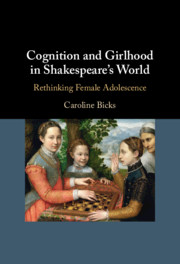Book contents
- Cognition and Girlhood in Shakespeare’s World
- Cognition and Girlhood in Shakespeare’s World
- Copyright page
- Dedication
- Contents
- Figures
- Acknowledgements
- Introduction
- Chapter 1 “A spectacle to men and angells”
- Chapter 2 “Imagination helps me”
- Chapter 3 “The progresse of an Art”
- Chapter 4 “If I should tell / My history”
- Chapter 5 “Put on the minde”
- Chapter 6 “From thirteene Yeares … resolved to serve God”
- Coda
- Notes
- Bibliography
- Index
Introduction
The Change of Fourteen Years
Published online by Cambridge University Press: 24 June 2021
- Cognition and Girlhood in Shakespeare’s World
- Cognition and Girlhood in Shakespeare’s World
- Copyright page
- Dedication
- Contents
- Figures
- Acknowledgements
- Introduction
- Chapter 1 “A spectacle to men and angells”
- Chapter 2 “Imagination helps me”
- Chapter 3 “The progresse of an Art”
- Chapter 4 “If I should tell / My history”
- Chapter 5 “Put on the minde”
- Chapter 6 “From thirteene Yeares … resolved to serve God”
- Coda
- Notes
- Bibliography
- Index
Summary
The Introduction lays the groundwork for the book’s central argument: that in post-Reformation England, when girls were expected to marry and turn their minds toward husbands, early moderns viewed the stage of girlhood between puberty and marriage as one of cognitive liberty and productivity. The Introduction explains how the brain’s anatomy and mental faculties were commonly perceived, and when and to what extent the brain came to be sexed. It traces the transmission of ancient and medieval depictions of pubertal change, and demonstrates how early modern English adaptations of these sources reveal a gendered shift in the cognitive vocabulary used to describe what happens to male and female body-minds when they experienced “the change of fourteen years.” It articulates the interdisciplinary conceptual frameworks that inform the study: theories of embodied cognition, studies of adolescence, work by historians of science on the early modern humoral body, and recent scholarship in Girls’ studies. Also included are discussions about constructing a feminist literary practice that analyzes depictions of embodied female experiences, and how early modern scholars largely have overlooked girls and failied to recognize the dynamic brainwork that Shakespeare and his contemporaries attributed to adolescent females, fictional and real.
Keywords
- Type
- Chapter
- Information
- Cognition and Girlhood in Shakespeare's WorldRethinking Female Adolescence, pp. 1 - 32Publisher: Cambridge University PressPrint publication year: 2021



